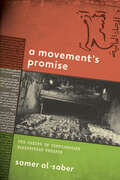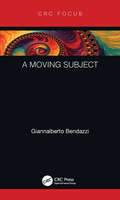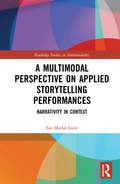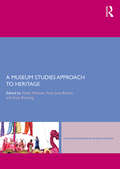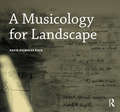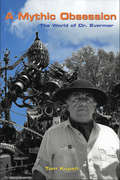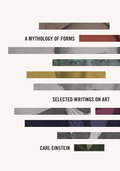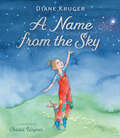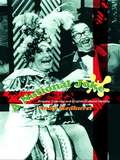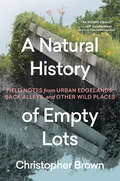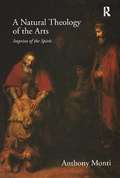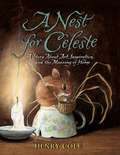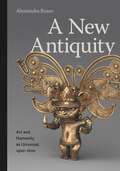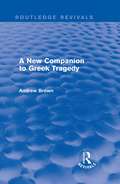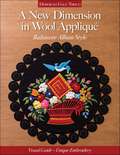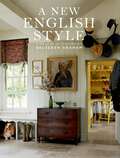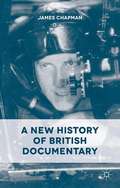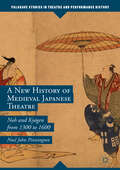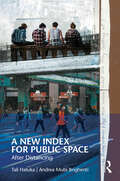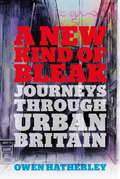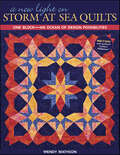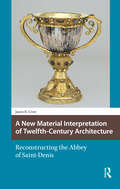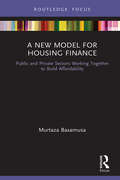- Table View
- List View
A Morphological Interpretation of a Northern Chinese Traditional Village: Case Study of Zhangdaicun Village
by Kun LiThis book challenges the definition of a new approach for integrating protection and enhancing the Chinese heritage category of “Traditional Villages”. By applying a specific case study in the Hancheng context, Shaanxi Province, which lacks sound studies, the book formulates new theoretical prerequisites for future re-searches, an in-depth knowledge path, and sound methodological principles. By working in a multiple scales approach, the object of preservation and enhancement is first of all redefined in its ontology as a unity formed by the courtyard type, the morphology of the village, and the related landscape structures. All these three levels of study have been deeply investigated, put into the relationship and resulting in a new methodology which overcomes the inadequacy and ineffectiveness of the notion of “setting” deriving from conservation Charters, to embrace the structural notion of “context” and a knowledge approach to rural settlements’ form. The innovative and original features of this book are both in the reading villages in their landscape dimension, which in turn is studied as a context made of several interrelated structures. Another original feature of the book is the integration of Italian historic-structural and morphological methodologies with specific Chinese cultural aspects. The author’s work dug deeply and interdisciplinary in all those dimensions to account for the complex issues that are related and embodied in both the physical and intangible meaning of human settlements, opening a novel scientific methodology for Chinese studies as a sound base to define three key integrated project actions: what, why, how to preserve, enhance, develop.
A Movement's Promise: The Making of Contemporary Palestinian Theater
by Samer Al-SaberStarting in the 1970s, Palestinian theater flourished as part of a Palestinian cultural spring. In the absence of local radio, television, and uncensored journalism, theater production became the leading form of artistic expression, and Palestinian theater artists self-identified as a movement. Although resistance was not their sole function, these theater makers contributed to an active cultural resistance front. With this book, Samer Al-Saber tells the story of the Palestinian Theater Movement over nearly three decades, as they created plays and productions that articulated versions of Palestinian identity, critiqued social norms, celebrated and extended Palestinian cultural values, and challenged the power disparity created by the Occupation. The struggles between Palestinian theater artists and Israeli authorities form the central relationships in this history. Al-Saber juxtaposes the agency of Palestinian theater artists, in their determination to perform against immense challenges, with the power of Israeli authorities to grant or deny permission to theatrical productions. The legal structure of institutionalized censorship prevented Palestinian artists from expressing their chosen message, and the theater movement's search for permission to perform illuminates the disparity in power between the occupier and the occupied. In writing the first history of the Palestinian Theater Movement, Al-Saber amplifies necessary voices in this Palestinian cultural history, told from below.
A Moving Subject
by Giannalberto BendazziDescription: A Moving Subject offers a collection of essays from around the world. From Italy to the Middle East, from an analysis of A Night on Bald Mountain to African cinema animation, these essays help to paint the world of animation in a comprehensive and international manner. Handpicked by renowned animation historian and researcher Giannalberto Bendazzi, this book offers a look at the global foundations of animation from disparate regions, peoples and methods, and helps to demonstrate animation as a unifying factor of the human race. Key Features: A fresh perspective on animation from a global lens A new look into traditional animation produced from around the world Essays that reflect on the nature of colour, animation and light Author: A former professor at the Nanyang Technological University of Singapore and the Università degli Studi of Milan, Italian-born Giannalberto Bendazzi has thoroughly investigated the history of animation for more than forty years. A founding member of the Society for Animation Studies, he has authored or edited various classics in various languages and has lectured extensively on every continent. He received an honorary doctorate from Lisbon University in 2019.
A Multimodal Perspective on Applied Storytelling Performances: Narrativity in Context (Routledge Studies in Multimodality)
by Soe Marlar LwinIn this volume, Soe Marlar Lwin proposes a contextualized multimodal framework that brings together storytelling practitioners’ and academic researchers’ conceptions of storytelling. It aims to highlight the ways in which various institutions in contemporary society have been using live storytelling performances as an effective communicative, educative and meaning-making tool. Drawing on theories of narrative from narratology as well as from related fields such as discourse analysis, multimodal analysis, communication and performance studies, the author proposes a contextualized multimodal framework to (a) uncover the potential narrativity of a live storytelling performance through an analysis of narrative elements constituting the story, (b) capture the process of developing actual narrativity through a multimodal analysis of performance features in the storytelling discourse, and (c) highlight the importance of context and dynamics between the storyteller and audience for an achievement of optimal narrativity in a particular storytelling event. The sample analysis shows how the framework not only describes the system governing institutionalized storytelling performances in general but also serves as a useful model to examine individual performance as a unique realization of the general system. The book also offers implications for possible applications of such contextualized multimodal frameworks more broadly across the disciplines.
A Museum Studies Approach to Heritage (Leicester Readers in Museum Studies)
by Sheila Watson Amy Jane Barnes Katy BunningHeritage’s revival as a respected academic subject has, in part, resulted from an increased awareness and understanding of indigenous rights and non-Western philosophies and practices, and a growing respect for the intangible. Heritage has, thus far, focused on management, tourism and the traditionally ‘heritage-minded’ disciplines, such as archaeology, geography, and social and cultural theory. Widening the scope of international heritage studies, A Museum Studies Approach to Heritage explores heritage through new areas of knowledge, including emotion and affect, the politics of dissent, migration, and intercultural and participatory dimensions of heritage. Drawing on a range of disciplines and the best from established sources, the book includes writing not typically recognised as 'heritage', but which, nevertheless, makes a valuable contribution to the debate about what heritage is, what it can do, and how it works and for whom. Including heritage perspectives from beyond the professional sphere, the book serves as a reminder that heritage is not just an academic concern, but a deeply felt and keenly valued public and private practice. This blending of traditional topics and emerging trends, established theory and concepts from other disciplines offers readers international views of the past and future of this growing field. A Museum Studies Approach to Heritage offers a wider, more current and more inclusive overview of issues and practices in heritage and its intersection with museums. As such, the book will be essential reading for postgraduate students of heritage and museum studies. It will also be of great interest to academics, practitioners and anyone else who is interested in how we conceptualise and use the past.
A Musicology for Landscape (Design Research in Architecture)
by David Nicholas BuckDrawing conceptually and directly on music notation, this book investigates landscape architecture’s inherent temporality. It argues that the rich history of notating time in music provides a critical model for this under-researched and under-theorised aspect of landscape architecture, while also ennobling sound in the sensory appreciation of landscape. A Musicology for Landscape makes available to a wider landscape architecture and urban design audience the works of three influential composers – Morton Feldman, György Ligeti and Michael Finnissy – presenting a critical evaluation of their work within music, as well as a means in which it might be used in design research. Each of the musical scores is juxtaposed with design representations by Kevin Appleyard, Bernard Tschumi and William Kent, before the author examines four landscape spaces through the development of new landscape architectural notations. In doing so, this work offers valuable insights into the methods used by landscape architects for the benefit of musicians, and by bringing together musical composition and landscape architecture through notation, it affords a focused and sensitive exploration of temporality and sound in both fields.
A Mythic Obsession: The World of Dr. Evermor
by Tom KupshIn addition to hundreds of whimsical welded sculptures, Tom Every poured most of his effort into the Forevertron, the world's largest sculpture built by a single person, and in the process, he discovered his alter ego: Dr. Evermor. With the full participation of Tom and Eleanor Every, Every's amazing life is keenly documented, including never published family photos, sketches, and personal memories, producing a detailed portrait of a unique self-taught artist. From a very early age, Every collected, modified, and resold cast-off industrial material. His work as a salvager led him to Alex Jordan Jr., creator of the House on the Rock. When the time is right (and only Dr. Evermor will know when) the famous, enigmatic scientist will climb the winding staircase of the Forevertron and enter its egg-shaped travel chamber, power up the dynamos and flip on the thrusters, and fly away on a "highball to heaven," propelled by an electromagnetic lighting force beam. Or so the story goes. Anyone who has spent time at the elaborate visionary environment created by Tom Every has heard some variation of the Evermor myth. Lesser known is the story behind the story, the fascinating history of this one-of-a-kind creative spirit.
A Mythology of Forms: Selected Writings on Art
by Carl EinsteinThe German art historian and critic Carl Einstein (1885-1940) was at the forefront of the modernist movement that defined the twentieth century. One of the most prolific and brilliant early commentators on cubism, he was also among the first authors to assess African sculpture as art. Yet his writings remain relatively little known in the Anglophone world. With A Mythology of Forms, the first representative collection of Einstein’s art theory and criticism to appear in English translation, Charles W. Haxthausen fills this gap. Spanning three decades, it assembles the most important of Einstein’s writings on the art that was central to his critical project—on cubism, surrealism, Pablo Picasso, Georges Braque, and Paul Klee, and includes the full texts of his two pathbreaking books on African art, Negro Sculpture (1915) and African Sculpture (1921). With fourteen texts by Einstein, each presented with extensive commentary, A Mythology of Forms will bring a pivotal voice in the history of modern art into English.
A Name from the Sky
by Diane KrugerFrom actress and mom Diane Kruger comes an enchanting story about how learning the meaning of her name changed her life—and how our names can help us find our own special powers.&“Beautiful….Such a great new baby gift - on my go-to gift list.&” — Zibby Owens, Moms Don&’t Have Time to Read Books&“Beautiful.&” — Hoda Kotb, Today with Hoda & Jenna"Diane Kruger is celebrating the power of a name." — People Magazine. Do you know where your name comes from? Growing up in Germany, like so many children around the world, Diane Kruger felt like she didn't fit in with the other kids. There was the pet bunny she talked to like a friend, her love of books, and even her name, which was unusual for her country. But when Diane&’s mother tells her the origin of her name—everything changes! Inspired by Diana, goddess of the hunt and magical protector of animals, Diane learns that she, too, will find her own special powers someday. On a trip to England, Diane and her mother visit the theater, and she is spellbound, realizing she&’s meant to be an actress. This warm and relatable autobiographical story comes full circle when Diane explains how she chose her own daughter&’s name, and invites readers to learn the meaning behind their own name and discover their own special powers. Illustrated in a classic storybook style by fine artist Christa Unzner, this book is sure to instill wonder as it inspires children to follow their dreams and passions.
A National Joke: Popular Comedy and English Cultural Identities
by Andy MedhurstComedy is crucial to how the English see themselves. This book considers that proposition through a series of case studies of popular English comedies and comedians in the twentieth century, ranging from the Carry On films to the work of Mike Leigh and contemporary sitcoms such as The Royle Family, and from George Formby to Alan Bennett and Roy 'Chubby' Brown. Relating comic traditions to questions of class, gender, sexuality and geography, A National Joke looks at how comedy is a cultural thermometer, taking the temperature of its times. It asks why vulgarity has always delighted English audiences, why camp is such a strong thread in English humour, why class influences what we laugh at and why comedy has been so neglected in most theoretical writing about cultural identity. Part history and part polemic, it argues that the English urgently need to reflect on who they are, who they have been and who they might become, and insists that comedy offers a particularly illuminating location for undertaking those reflections.
A Natural History of Empty Lots: Field Notes from Urban Edgelands, Back Alleys, and Other Wild Places
by Christopher BrownAn "instant classic", this genre-bending blend of naturalism, memoir, and social manifesto is a fascinating study for rewilding the city, the self, and society (Jeff VanderMeer, New York Times bestselling author). During the real estate crash of the late 2000s, Christopher Brown purchased an empty lot in an industrial section of Austin, Texas. The property—abandoned and full of litter and debris—was an unlikely site for a home. Brown had become fascinated with these empty lots around Austin, so-called &“ruined&” spaces once used for agriculture and industry awaiting their redevelopment. He discovered them to be teeming with natural activity, and embarked on a twenty-year project to live in and document such spaces. There, in our most damaged landscapes, he witnessed the remarkable resilience of wild nature, and how we can heal ourselves by healing the Earth. Beautifully written and philosophically hard-hitting, A Natural History of Empty Lots offers a new lens on human disruption and nature, offering a sense of hope among the edgelands. &“Brown lives far from any conventional battlefield, but he is surrounded by the wreckage of a different war, and he, too, finds hope in cultivating the ruins of nature…A Natural History of Empty Lots is less a departure from the nature writing tradition than a welcome addition to its edgelands.&” —New York Review of Books "The nature writing we need now." —Michelle Nijhuis, author of Beloved Beasts"Incredible" —Kelly Link, Pulitzer Prize finalist
A Natural Theology of the Arts: Imprint of the Spirit
by Anthony MontiA Natural Theology of the Arts contends that the arts are theological by their very nature and not simply when they are explicitly religious - thereby constituting a distinctive kind of 'natural theology'. Borrowing from science the stance of 'critical realism' to justify truth claims in art and theology, it argues that works of art are complex metaphors that convey the 'real presence' of God, even when not labeled as such.
A Nest For Celeste: A Story About Art, Inspiration, and the Meaning of Home
by Henry ColeCeleste is a mouse who is looking for a home. Is it nestled in the toe of a warm boot? In the shirt pocket of Celeste's new friend Joseph, who is Audubon's apprentice? Or is home the place deep inside Celeste's heart, where friendships live?
A New Antiquity: Art and Humanity as Universal, 1400–1600
by Alessandra RussoWe tend to think of sixteenth-century European artistic theory as separate from the artworks displayed in the non-European sections of museums. Alessandra Russo argues otherwise. Instead of considering the European experience of “New World” artifacts and materials through the lenses of “curiosity” and “exoticism,” Russo asks a different question: What impact have these works had on the way we currently think about—and theorize—the arts?Centering her study on a vast corpus of early modern textual and visual sources, Russo contends that the subtlety and inventiveness of the myriad of American, Asian, and African creations that were pillaged, exchanged, and often eventually destroyed in the context of Iberian colonization—including sculpture, painting, metalwork, mosaic, carving, architecture, and masonry—actually challenged and revolutionized sixteenth-century European definitions of what art is and what it means to be human. In this way, artifacts coming from outside Europe between 1400 and 1600 played a definitive role in what are considered distinctively European transformations: the redefinition of the frontier between the “mechanical” and the “liberal” arts and a new conception of the figure of the artist.Original and convincing, A New Antiquity is a pathbreaking study that disrupts existing conceptions of Renaissance art and early modern humanity. It will be required reading for art historians specializing in the Renaissance,scholars of Iberian and Latin American cultures and global studies, and anyone interested in anthropology and aesthetics.
A New Approach to the Arts: Tracing the Roots of Artistic Representation
by Peter MooreThis book considers how art actually works, how the various art forms connect with the world of ordinary human experience. Many books approach the subject from the top down, through topics such as the nature of beauty, the meaning of art, aesthetic judgement, and so on. The present book examines the subject from the ground up, so to speak, showing how the creation and appreciation of art spring from innate human needs and capacities. What we call ‘the arts’ emerge organically from the habitual activities through which human beings represent the world to themselves and others. Artistic representation, always more than mere imitation, is a reaching for the spirit of a subject, a revealing of the implicit, a refreshing of the overly familiar. A key idea is that art is representation through convention – that artistic conventions, far from inhibiting the work of the artist, are vital to artistic creativity.
A New Companion to Greek Tragedy (Routledge Revivals)
by Andrew BrownThat the works of the ancient tragedians still have an immediate and profound appeal surely needs no demonstration, yet the modern reader continually stumbles across concepts which are difficult to interpret or relate to – moral pollution, the authority of oracles, classical ideas of geography – as well as the names of unfamiliar legendary and mythological figures. A New Companion to Greek Tragedy provides a useful reference tool for the ‘Greekless’ reader: arranged on a strictly encyclopaedic pattern, with headings for all proper names occurring in the twelve most frequently read tragedies, it contains brief but adequately detailed essays on moral, religious and philosophical terms, as well as mythical genealogies where important. There are in addition entries on Greek theatre, technical terms and on other writers from Aristotle to Freud, whilst the essay by P. E. Easterling traces some connections between the ideas found in the tragedians and earlier Greek thought.
A New Dimension in Wool Appliqué: Baltimore Album Style
by Deborah Gale TiricoGive Baltimore Album designs dimension with felted wool Honor the legacy and history of Baltimore Album blocks with Deborah Tirico's distinctive appliqué style! With luscious felted wool and textures as rich as the history they depict, well-known motifs are the basis for 9 appliqué projects from table rugs and pillows to pincushions. No-fray wool appliqué is a perfect take-along project for leisurely stitching with no turned edges. Perfect techniques such as trapunto, layering, stuffing, needle-slanting, and beading with this complete visual guide, which also includes full-size templates and tips for personalizing Baltimore classics. - No turned edges! Easy-to-learn, dimensional wool appliqué—classic Baltimore Album motifs - Join the slow-sewing movement with 9 small appliqué and embroidery projects like pillows and table rugs - Learn Deborah Tirico's dimensional felted-wool techniques such as beading, trapunto, layering, and needle-slanting
A New English Style: Timeless Interiors
by David Nicholls Mary Graham Nicole SalvesenStep into the enchanting world of Nicole Salvesen and Mary Graham, two visionary designers known for their English country house style, who are celebrated for their ‘future heritage’ approach to interiors.In this, their debut book, Salvesen and Graham invite you to explore the art of creating classically beautiful and thoughtfully curated living spaces that transcend trends and stand the test of time. Featuring a treasure trove of stunning images, they share invaluable insights, guiding you on a journey to decorate your home in a way that is as stylish and inviting today as it will be in years to come.
A New History of British Documentary
by James ChapmanA New History of British Documentary is the first comprehensive overview of documentary production in Britain from early film to the present day. It covers both the film and television industries and demonstrates how documentary practice has adapted to changing institutional and ideological contexts.
A New History of Medieval Japanese Theatre: Noh and Kyōgen from 1300 to 1600 (Palgrave Studies in Theatre and Performance History)
by Noel John PinningtonThis book traces the history of noh and kyōgen, the first major Japanese theatrical arts. Going beyond P. G. O'Neill's Early Nō Drama of 1958, it covers the full period of noh's medieval development and includes a chapter dedicated to the comic art of kyōgen, which has often been left in noh's shadow. It is based on contemporary research in Japan, Asia, Europe and America, and embraces current ideas of theatre history, providing a richly contextualized account which looks closely at theatrical forms and genres as they arose. The masked drama of noh, with its ghosts, chanting and music, and its use in Japanese films, has been the object of modern international interest. However, audiences are often confused as to what noh actually is. This book attempts to answer where noh came from, what it was like in its day, and what it was for. To that end, it contains sections which discuss a number of prominent noh plays in their period and challenges established approaches. It also contains the first detailed study in English of the kyōgen repertoire of the sixteenth-century.
A New Index for Public Space: After Distancing
by Tali Hatuka Andrea Mubi BrighentiA New Index for Public Space: After Distancing offers readers a re-evaluation of the notion of publicness as a lens to unpack the complexity of urban space. A "new index" is proposed to reconstitute the promises and the predicaments of public space to better prepare for the contemporary challenges of post-pandemic, conflict-ridden society. Part I provides a theoretical introduction to the idea of public space and publicness, laying out the book’s rationale; Part II offers a new index of terms, including affects, alignments, atmosphere, conviviality, diagrams, documenting, flow, and more; and Part III applies the proposed lexicon with a "random walk" approach, inviting the reader to use the lens of nonlinear evolutionary dynamics as a means for envisioning the future of publicness. This book is the outcome of a conversation across disciplines – specifically, urban design and social theory – revolving around the recognition that public space is inherently fragile, messy, conflicted, and evolving. This book will be of interest to urban planners, architects, and urban designers, as well as human geographers, sociologists, political theorists, and those working in community development.
A New Kind of Bleak
by Owen HatherleyIn A Guide to the New Ruins of Great Britain, Owen Hatherley skewered New Labour's architectural legacy in all its witless swagger. Now, in the year of the Diamond Jubilee and the London Olympics, he sets out to describe what the Coalition's altogether different approach to economic mismanagement and civic irresponsibility is doing to the places where the British live.In a journey that begins and ends in the capital, Hatherley takes us from Plymouth and Brighton to Belfast and Aberdeen, by way of the eerie urbanism of the Welsh valleys and the much-mocked splendour of modernist Coventry. Everywhere outside the unreal Southeast, the building has stopped in towns and cities, which languish as they wait for the next bout of self-defeating austerity.Hatherley writes with unrivalled aggression about the disarray of modern Britain, and yet this remains a book about possibilities remembered, about unlikely successes in the midst of seemingly inexorable failure. For as well as trash, ancient and modern, Hatherley finds signs of the hopeful country Britain once was and hints of what it might become.
A New Light on Storm at Sea Quilts
by Wendy MathsonTake this Scrap-Quilter's Favorite in Bold New Directions • Open up new creative possibilities for the traditional Storm at Sea block with innovative design and construction techniques • Make 6 elegantly curved Storm at Sea quilt projects with all straight-line piecing • Assemble your blocks the easy way with fast2cut Quilters' TRIMplate trimming rulers, or use the included full-size patterns for paper piecing • See many other stunning Storm at Sea designs in the gallery of quilts, including several by nationally known quilters If you've never tried the beautiful Storm at Sea block because of its "hard-to-piece" reputation, you'll change your mind once you try Wendy's easy new piecing methods. But that's not all-you'll also learn to create your own Storm at Sea designs and bring dramatic new life to an old favorite.
A New Material Interpretation of Twelfth-Century Architecture: Reconstructing the Abbey of Saint-Denis (Knowledge Communities)
by Jason CrowToday, we perceive Gothic cathedrals as light-filled forms representing the sacred. The colored light projected from brightly-colored stained glass windows onto the walls and floors of these buildings suggests the presence of divinity. Suger (1081–1151CE), the abbot of the monastery of Saint-Denis, is credited with originating Gothic architecture. However, focus on form and structure has elided attention to the material out of which medieval churches were made. When Suger describes the early church he was replacing, he says that the gold and gems it contained beamed outwardly with a gleaming light that filled the eye. When he restored his church and filled it with the shining souls of his ecclesia, he repeated God’s divine act of creation. His restored church imitated the precious stones that could be shaped and polished to reveal divine light. By crafting stone, Suger fulfilled the divine plan to make heaven on earth. This book • Reassesses the origins and significance of “Gothic” architecture • Approaches the interpretation of the twelfth-century church through its materiality Integrates the twelfth-century conceptualization of architecture within art, science, and theology.
A New Model for Housing Finance: Public and Private Sectors Working Together to Build Affordability
by Murtaza BaxamusaA New Model for Housing Finance presents a thought-provoking solution to the housing crisis that follows the division of public and private money on housing costs and benefits. It brings a practical perspective on why housing is unaffordable, and what can be done about it using public and private capital. This book re-examines the foundation of housing finance in the United States with the aim to shift the paradigm from the public and private sectors working in silos, to working together. Through brief yet rigorous chapters, the book assesses the policy failures of both public and private sectors by drawing attention to the continuing human impacts of this man-made crisis, finally calling for a new model of financing housing through public–private partnerships. The limited impact and false hope of planning interventions, as well as the widespread economic impacts of the global pandemic of 2020, demonstrate the urgent need for change in our approach to housing policy, and this book lays out a path forward. It will be of interest to anyone working in or studying housing, social justice, urban planning, urban studies, and public policy.

